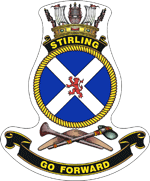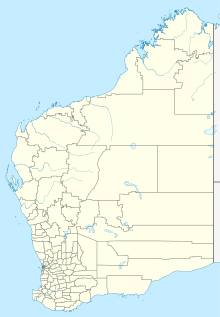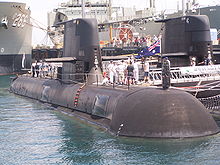
The Royal Australian Navy (RAN) is the naval force of the Australian Defence Force (ADF). The professional head of the RAN is Chief of Navy (CN) Vice Admiral Mark Hammond AM, RAN. CN is also jointly responsible to the Minister of Defence (MINDEF) and the Chief of Defence Force (CDF). The Department of Defence as part of the Australian Public Service administers the ADF.

Garden Island is a narrow island about 10 kilometres (6 mi) long and 1.5 kilometres (0.9 mi) wide, lying about 5 kilometres (3 mi) off the Western Australian coast, to which it is linked by an artificial causeway and bridge.
USS Tunny (SSN-682), a Sturgeon-class attack submarine, was the second submarine of the United States Navy to be named for the tunny, any of several oceanic fishes resembling the tuna.

HMAS Waller is the third of six Collins-class submarines operated by the Royal Australian Navy (RAN).

Garden Island is an inner-city locality of Sydney, Australia, and the location of a major Royal Australian Navy (RAN) base. It is located to the north-east of the Sydney central business district and juts out into Port Jackson, immediately to the north of the suburb of Potts Point. Used for government and naval purposes since the earliest days of the colony of Sydney, it was originally a completely-detached island but was joined to the Potts Point shoreline by major land reclamation work during World War II.

HMAS Anzac is the lead ship of the Anzac-class frigates in use with the Royal Australian Navy (RAN) and the Royal New Zealand Navy (RNZN). Entering Australian service in 1996, the frigate operated as part of the INTERFET peacekeeping taskforce in 1999. In 2003, she was involved in the Battle of Al Faw, and became the first RAN ship to fire in anger since the Vietnam War.

HMAS Perth is an Anzac-class frigate of the Royal Australian Navy (RAN). The last ship of the class to be completed, she was built by Tenix Defence and commissioned into the RAN in 2006. In 2007, Perth became the first major warship of the RAN to be commanded by a woman. During 2010 and 2011, the frigate was used as the testbed for a major upgrade to the Anzac class' ability to defend themselves from anti-ship missiles.

A target ship is a vessel — typically an obsolete or captured warship — used as a seaborne target for naval gunnery practice or for weapons testing. Targets may be used with the intention of testing effectiveness of specific types of ammunition; or the target ship may be used for an extended period of routine target practice with specialized non-explosive ammunition. The potential consequences of a drifting wreck require careful preparation of the target ship to prevent pollution, or a floating or submerged collision risk for maritime navigation.
The Royal Australian Navy, although a significant force in the Asia-Pacific region, is nonetheless classed as a medium-sized navy. Its fleet is based around two main types of surface combatant, with limited global deployment and air power capability. However, in 2009, a white paper, Defending Australia in the Asia Pacific Century: Force 2030, was produced by the Australian government which set out a programme of defence spending that will see significant improvements to the RAN's fleet and capabilities.

HMAS Kuttabul is a Royal Australian Navy (RAN) base located in Potts Point in Sydney, New South Wales, Australia. Kuttabul provides administrative, training, logistics and accommodation support to naval personnel assigned to the various facilities that form Fleet Base East, the main operational navy base on the east coast of Australia. A part of Fleet Base East itself, Kuttabul occupies several buildings in the Sydney suburb of Potts Point and in the immediately adjacent Garden Island dockyard. It also supports navy personnel posted to other locations throughout the greater Sydney region.

Fleet Base East is a Royal Australian Navy (RAN) major fleet base that comprises several naval establishments and facilities clustered around Sydney Harbour, centred on HMAS Kuttabul. Fleet Base East extends beyond the borders of Kuttabul and includes the commercially-operated dockyard at Garden Island, and adjacent wharf facilities at nearby Woolloomooloo, east of the Sydney central business district in New South Wales, Australia. Fleet Base East is one of two major facilities of the RAN, the other facility being Fleet Base West. The fleet operates in the Pacific Ocean.

The history of the Royal Australian Navy traces the development of the Royal Australian Navy (RAN) from the colonisation of Australia by the British in 1788. Until 1859, vessels of the Royal Navy made frequent trips to the new colonies. In 1859, the Australia Squadron was formed as a separate squadron and remained in Australia until 1913. Until Federation, five of the six Australian colonies operated their own colonial naval force, which formed on 1 March 1901 the Australian Navy's (AN) Commonwealth Naval Force which received Royal patronage in July 1911 and was from that time referred to as Royal Australian Navy (RAN). On 4 October 1913 the new replacement fleet for the foundation fleet of 1901 steamed through Sydney Heads for the first time.

The Royal Australian Navy Submarine Service is the submarine element of the Royal Australian Navy. The service currently forms the Navy's Submarine Force Element Group (FEG) and consists of six Collins class submarines.
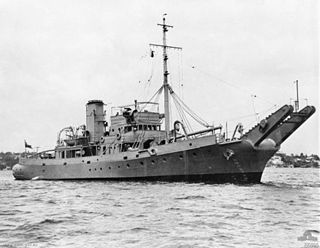
HMAS Karangi was a Kangaroo-class boom defence vessel operated by the Royal Australian Navy (RAN) during World War II. The third of three ships constructed by the Cockatoo Docks and Engineering Company at Cockatoo Island Dockyard based on the British Bar-class, Karangi was launched on 16 August 1941. After the war, the ship remained in active service with the RAN and played a small but key role in the British nuclear testing program. She was placed in reserve in 1953. In 1955, Karangi was reactivated and served for another two years until May 1957 and was eventually sold for scrap in 1966.

The Australian Marine Complex (AMC) is a marine industry precinct located at Henderson, Western Australia, 23km south of the Perth CBD. It is located on Cockburn Sound.

Overseas military bases of the United Kingdom enable the British Armed Forces to conduct expeditionary warfare and maintain a forward presence. Bases tend to be located in or near areas of strategic or diplomatic importance, often used for the build-up or resupply of military forces, as was seen during the 1982 Falklands War and the use of RAF Ascension Island as a staging post. Most of the bases are located on British Overseas Territories or former colonies which retain close diplomatic ties with the British government.
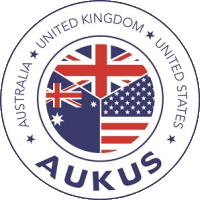
AUKUS, also styled as Aukus, is a trilateral security partnership for the Indo-Pacific region between Australia, the United Kingdom, and the United States. Announced on 15 September 2021, the partnership involves the US and the UK assisting Australia in acquiring nuclear-powered submarines. The partnership also includes cooperation on advanced cyber mechanisms, artificial intelligence and autonomy, quantum technologies, undersea capabilities, hypersonic and counter-hypersonic, electronic warfare, innovation and information sharing. The partnership will focus on military capability, distinguishing it from the Five Eyes intelligence-sharing alliance that also includes New Zealand and Canada.

The SSN-AUKUS, also known as the SSN-A, is a planned class of nuclear-powered fleet submarine (SSN) intended to enter service with the United Kingdom's Royal Navy in the late 2030s and Royal Australian Navy in the 2040s. The class will replace the UK's Astute class and Australia's Collins class submarines.
The Australian Submarine Agency (ASA), formerly the Nuclear-Powered Submarine Task Force (NPSTF) is the federal statutory agency of the Australian Government responsible for the management and oversight of Australia's nuclear-powered submarine program. The ASA was established as a non-corporate Commonwealth entity under the Department of Defence consisting of defence personnel and Australian public servants. Personnel will be based across Australia as well as in the United Kingdom and the United States, numbering 350 increasing to 680 within the following year.
